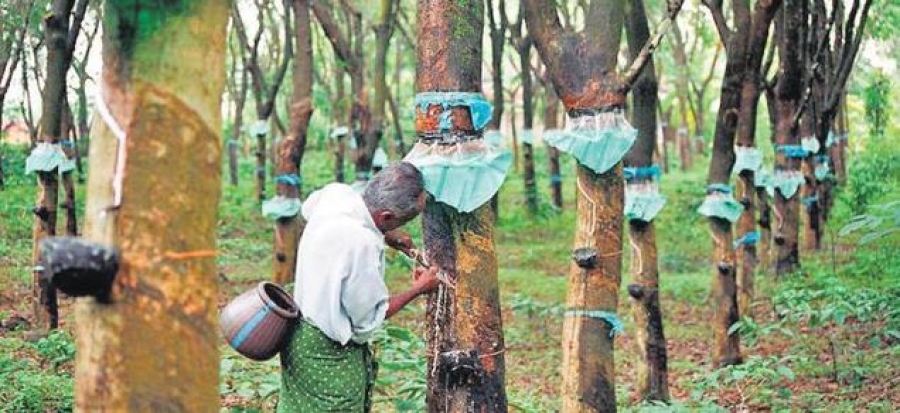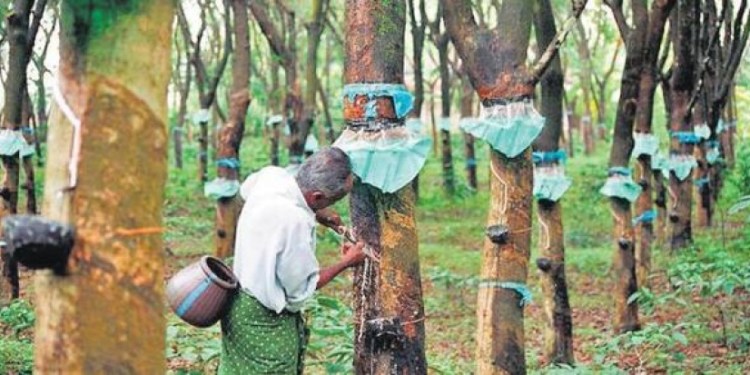Weekly production down by 500 tonnes after Kerala deluge
 KOCHI, AUGUST 27
KOCHI, AUGUST 27
Production of rubber is certain to see a fall this year, with plantations in Kerala, especially in the central Travancore belt, experiencing an abnormal leaf-fall disease in the wake of the unprecedented rain of the last few months.
The emerging situation has impacted production and the Rubber Board is collecting data, which is likely to be published in a week. There are also reports of shoot-rot disease in immature plantations, which may result in the delayed maturity of plantations. There is a shortage in the market and the trade is also getting affected, sources in the Rubber Board said.
The output concern has already resulted in a firming trend in rubber prices over the past few days. Spot rubber prices, which were hovering around ₹131 per kg in early August have now moved up to ₹134 per kg. Similarly, rubber futures on the National Multi Commodity Exchange settled higher on supply concerns. The September contract ended at ₹13,425 per 100 kg on the NMCE on Monday.
Shajimon Jose of Chirakkadavu RPS in Kanjirappilli said production has come down in the last couple of weeks, at 1,000-1,200 tonnes against the Board’s targeted weekly production of 1,500 tonnes.
The rains, which began in April, also resulted in the loss of almost 40 tapping days per hectare. Lower price realisation is also staring at the sector, impacting cultivation in large areas.
Besides, GST has forced the sector to bleed. For natural rubber, rates are very nominal, at 5 per cent. But other inputs, such as plastic, gum, spill, tapping cup, cup holder etc invites a GST rate of 18 per cent. The rain guarding cost per tree has risen to ₹6.20, he said.
PC Cyriac, President of the Indian Farmers Movement blamed the low prices on imports. As long as these shipments are not reduced, he said, the situation will worsen. He urged the captains of the manufacturing industry to offer viable prices for domestic rubber.
Tyre lobby fears output fall
Rajiv Budharaja, Director General, Automotive Tyre Manufacturers Association, said that production is expected to be gravely affected due to incessant rains and floods. Already, the gap between production and demand is widening. In Q1, more than 40 per cent of the demand had to be met from imports due to a domestic deficit.
There was limited tapping in July because of rains and in August, there has been virtually no production. Arrivals in the market are practically nil. On the other hand, there is a sudden upsurge in demand from OEMs for commercial vehicles and tractor tyres. Both these categories are very intensive in using natural rubber.
“The industry expects a gap of over half a million tonnes in the ongoing fiscal. This definitely needs the attention of the government,” he said.
There is a need to assess and re-look at the medium-term situation because of damage to plantations. Each rubber tree has a life span of 25-30 years. An assessment also needs to be carried out to see how natural rubber production is affected, he added.
Meanwhile, India Ratings & Research said the disruption in natural rubber supply from Kerala would force the tyre companies to resort to higher imports to meet rising tyre demand. Domestic production meets over 50 per cent of the requirements of tyre companies in India and Kerala accounts for close to 90 per cent of the total domestic rubber production. Natural rubber imports attract a duty of 25 per cent. Additionally, with a depreciating rupee, imports are likely to be more expensive and thus will hurt margins of tyre companies amid a rise in rubber procurement costs, IndRa said.






















